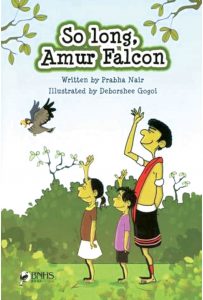Nagaland
Flight of the Amur falcon: A story worth (re)telling

Eastern Mirror Desk
Dimapur, April 26: Not long ago, the migratory Amur falcons arriving from south-eastern Siberia and northern China—flocking together in thousands in parts of Nagaland and the country—simply meant more prey to hunters.
Thousands of those small raptors, after flying thousands of miles, flock to the Doyang reservoir in Wokha district and in few other places of the state during the month of October till November end.
For many years, hunters have killed the bird for livelihood. But it all changed drastically when the Nagaland Wildlife and Biodiversity Conservation Trust started a campaign to save the migratory bird in 2013.
Led by the trust’s founder, and former editor of Eastern Mirror, Bano Haralu, their attempt to save the ‘winged guests’ instantly commanded global attraction—including that of the old and revered BBC.
Long story short, the hunters were turned into protectors. This too had made global news—seasoned hunters going all out to provide a safe haven to their former prey.
And now, this remarkable story is the centrepiece of the first children’s book to be published by the venerated Bombay Natural History Society (BNHS). Yes, the BNHS has published a children’s book on Nagaland’s journey to becoming the ‘falcon capital of the world.’
Written by Prabha Nair, the book titled, ‘So Long, Amur Falcon’ is the first children’s book published by BNHS. It narrates how the hunting grounds in Nagaland have now turned into a haven for the migratory bird. The book has been written for the age group of eight to 12.
According to a report in The Hindu, a coordinated programme by several non-governmental organisations and the government involving villagers and hundreds of schoolchildren stopped the mass killing of Amur falcons within a year’s time in Nagaland.
“We felt it was a story that all children in India should read about. It might motivate them to befriend birds in their region and understand more about the necessity to conserve our flora and fauna,” it quoted Deepak Apte, the president of BNHS, as saying.
“In a first for the 135-year-old institution, BNHS decided to bring out a book for children that would trace the flight of the Amur falcon and narrate how conservation efforts had resulted in saving it from being hunted during its long, migratory flight.”
According to the report, Prabha Nair—said to have worked in the editorial of the iconic Tinkle comics for six years when she was in Mumbai—was chosen to capture the story for children.
“I wanted to show how ecological changes can affect our lifestyle and how it is all connected. At the same time, I wanted to avoid being preachy or didactic,” explained Prabha in the report.
When contacted, Bano Haralu—who was not yet aware of the development—expressed delight at the news. She was happy that the conservation story of Amur falcons in Nagaland was being shared across the globe.
According to Haralu, this was all due to the collective effort of all those who have made the state proud. Yet again, her message was, “We all can be conservationists.” Conservation, she reminded, should not be limited only to the Amur falcons.
“I haven’t read the book but I’m sure it will make a very interesting read that weaves in scientific facts and ‘real life’ facts of villagers confronted to make a choice for the future or limit their action for the ‘now’. The truth is, in Nagaland (and northeast India) we are wrapped in nature’s amazing rich biodiversity. Hopefully, the book will inspire our own to look deeply at the world around us,” she said.

